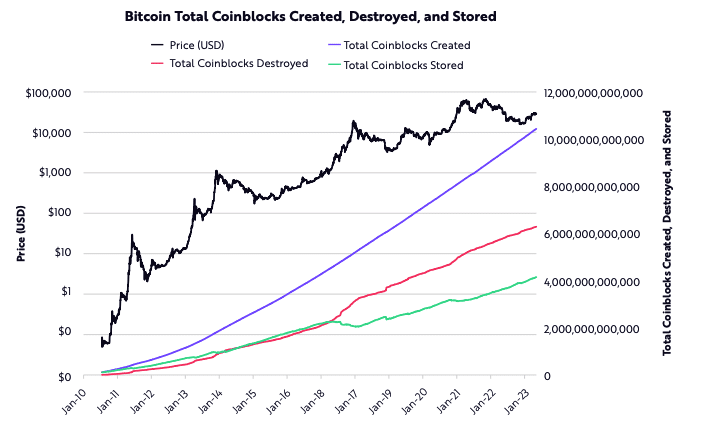- Using the coin block models, Cointime Economics can determine the movement of BTC.
- The on-chain metric can also identify the liveliness or inactivity of the network.
After 18 months of intensive research, a new on-chain metric has been added to the Bitcoin [BTC] clan. And the initiators are none other than the on-chain analytics platform Glassnode and the global asset management company ARK Invest.
How many Worth 1,10,100 BTC today?
As you probably know, on-chain metrics play a vital role in understanding Bitcoin network dynamics and market sentiment. For ARK Invest’s research associate David Puell and Glassnode’s lead analyst James Check, naming this new metric “Cointime Economics” was the best tag to represent the metric.
If you are familiar with the on-chain landscape, you would also realize that Puell, the famous creator of the Puell Multiple, is not new to the introduction of statistics. Check, on the other hand, is also recognized for its work in contributing to metrics development on the Glassnode platform. What exactly is Cointime Economics?
Coin blocks come to the rescue?
According to the partnership research paperCointime Economics would act as a fungible measure of Bitcoin supply and demand. In evaluating the metric, Check and Puell noted that some existing metrics should be taken into account.
These metrics include the market value to realized value (MVRV) ratio, the Bitcoin inflation rate, and volume-weighted costs.
Based on the information from the report, a combination of the statistics would help identify Bitcoin’s valuation. activityand economic condition. This then leads to the introduction of the coin blocks. The article explained the term as:
“Coinblocks are the product of the number of Bitcoins and the number of blocks produced during the period in which that Bitcoin remained immobile.”
But it doesn’t stop there. To assess Bitcoin’s economy, value, or network activity, the Coinblocks Created (CBD), Coinblock Destroyed (CBD), and Coinblocks Stored (CBS) would play different roles.
The CBD measures the time-weighted turnover of Bitcoin volume, or the number of Bitcoins moved in a given time period, holding period, or time before the move.
Destruction equals capitulation
So if there is heavy destruction of coin blocks, it suggests that long term holders are selling. It also implies that Bitcoin’s “smart money” is trading on a lower cost basis while generating higher profits.
Thus, large spikes in the destroyed coin blocks have had a high correlation to a spike in Bitcoin’s price.
On the other hand, Coinblocks Stored (CBS) represents the total number of coin blocks or the difference between the total number of coin blocks created and the total number of coin blocks destroyed.
When the CBS is negative over a seven-day period, it means that the number of coin blocks destroyed has exceeded the number created. This indicates the movement of a significant number of ancient coins in a short period of time.
If the CBS is positive, it means that the number of coin blocks created has exceeded the number of coin blocks destroyed. In this case, it would mean that fewer ancient coins have been moved in a short period of time.
Finally, the Coinblocks Created (CBC) represents the total coin time created in the Bitcoin network, regardless of coin movement. Combining all the parameters, Glassnode and ARK Invest considered what happened in 2017 when CBD surpassed CBS.

Source: ARK Invest and Glassnode
From the chart above, the research paper concluded that Cointime Economics formed building blocks over time. It was mentioned that at this point:
“There were more coins active in the market, rather than lost or heavily inactive.”
How vibrant is the economy?
Another model derived from the report to understand Bitcoin’s economic state was by using vibrance and vaultiness. For context, Bitcoin’s vibrancy is a value from 0 to 1, which represents the liquidation rate of long-term holders.
If the vibrancy increases, so will the long-term holders liquidate positions. However, a drop in the benchmark suggests that holders have decided to continue HODLing. In addition, Vaultedness measures network inactivity.
In case the liveliness rises to 1, there will be no Bitcoin holders. And when the vault reaches 1, it means that miners have never sold their BTC.

Source: ARK Invest and Glassnode
To check the economic position of Bitcoin, the Cointime Economics also takes into account the nominal and adjusted inflation rate. By definition, the inflation rate is the percentage of new coins divided by the current supply.
Lower inflation rate for BTC
To explain this, Puell and Check examined what happened to the statistics between 2013 and 2017, and at the time of writing. The conclusion was
“Conversely, from 2013 to 2017, currency inflation reached parity with headline inflation, only to surpass it as of the day of this publication.”
Realistic or not, here it is The market cap of BTC in ETH terms
At the time of writing, nominal and coin-adjusted inflation rates suggested that inflation was being underestimated. This was due to the slow appreciation of BTC, that was much lower than in previous years.

Source: Ark Invest and Glassnode
While the Bitcoin Cointime Economic is still in its infancy, there is no denying that the measure can provide more insight into market sentiment. Savvy money traders may need to assess other factors in addition to the evaluation to get a full picture of what it has to offer.











